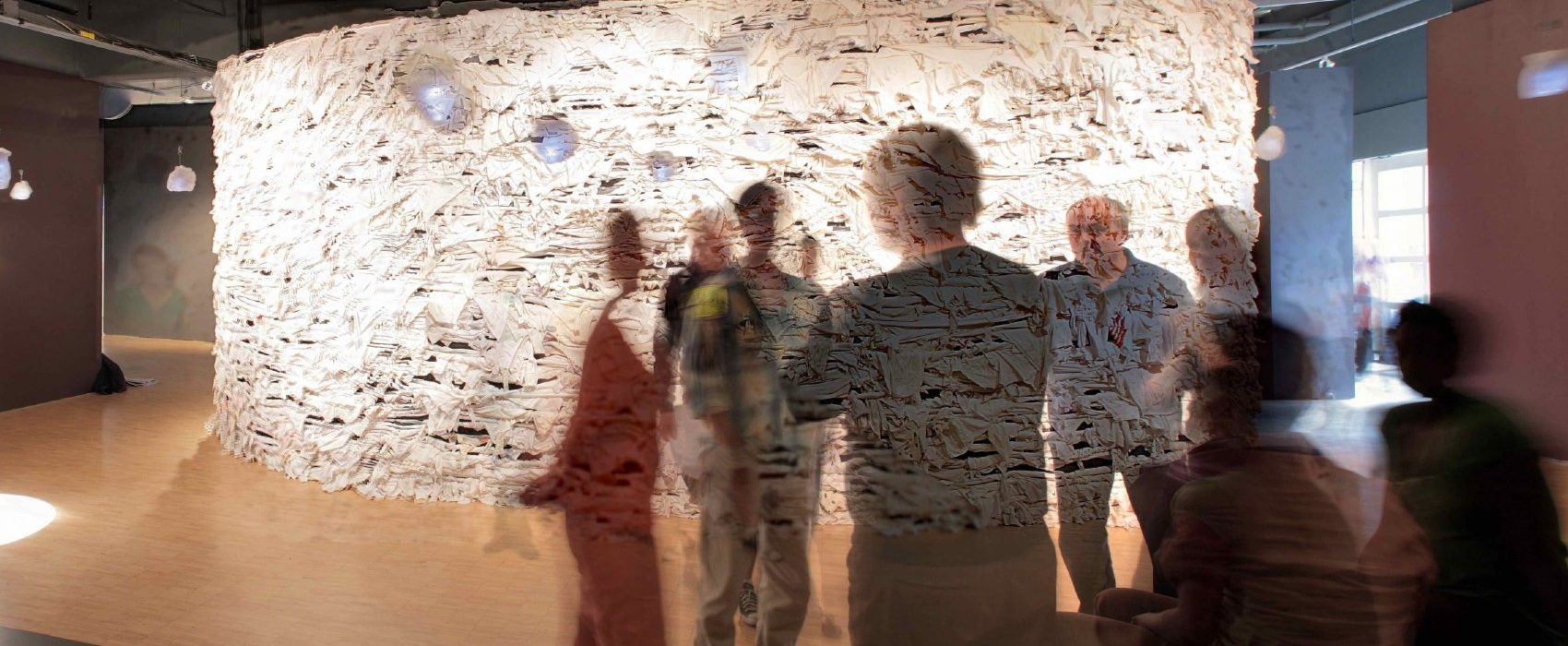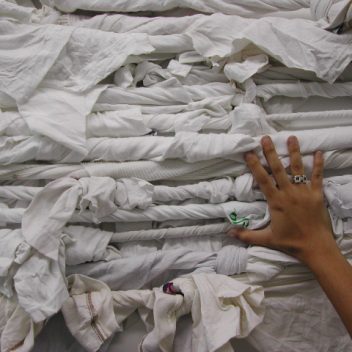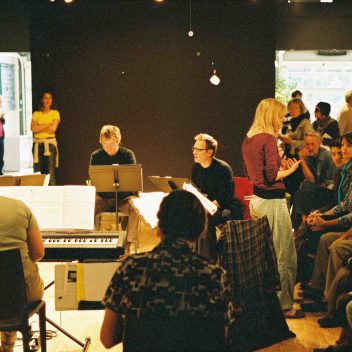
Image: Blue Note in rehearsal (Peter Legris)
Blue Note
Created by Martin Julien and Brian Quirt
Music won’t be made, but maybe music can be conjured, if you know how.
Blue Note takes place during the first rehearsal of an eight member vocal ensemble following the death of one of its singers. As they rehearse, the surviving singers reflect on the missing voice, how much they mourn (or not) the absent singer, and try to fill the missing space in the arrangements they have made. By inviting the audience into their wake-like rehearsal, Blue Note becomes an intimate character study of a vocal ensemble, encouraging spectators to become participants, follow the seven singers during the rehearsal, sitting as close as they wish while the rehearsal struggles onward, even singing along if they want. As in a piece of choral music, Blue Note offers a window into each singer, but the whole story is only revealed once all of their individual voices are singing together.
Production History
Harbourfront Centre, York Quay Gallery, Toronto
produced by Nightswimming and Harbourfront Centre as part of Fresh Ground New Works
September 11-21, 2008 – open rehearsals, noon-5pm
September 16-21, 2008 – performances, 7pm
Created by Martin Julien and Brian Quirt
Design by PLANT Architect Inc.
Produced by Naomi Campbell
Performed by Neema Bickersteth, Jay Bowen, Christine Brubaker, Steven Gallagher, Kate Hennig, John Millard & Jane Miller
Stage managed by Sandy Plunkett
Lighting Consultation by Trevor Schwellnus
Apprentice Director Ulla Laidlaw
Special thanks to workshop participants Thom Allison, Christine Duncan, Megan Hamilton, Andrew Kushnir, Doug McNaughton, Frank Moore, Imali Perera, Andrea Romaldi, Suba Sankaran & Jovanni Sy.
Nightswimming developed Blue Note from inception and was awarded a Fresh Ground New Works commission by Harbourfront Centre to stage the workshop production that was presented as part of World Stage.
PLANT Architect Inc. is an interdisciplinary design firm active in architecture, landscape, art, and graphic design, and recently won the Nathan Phillips Square Revitalization Competition. Blue Note team: Lisa Rapoport, Chris Pommer, Mary Tremain, Matt Hartney, Lisa Dietrich, Jessica Craig, Victoria Taylor.
Blue Note musical repertoire
Hush No More – Henry Purcell, from The Fairie Queen; Rise Up My Love – Healey Willan / John Millard arr.; God Moves in Mysterious Ways – R. Murray Schafer; O Magnify the Lord – Gospel, traditional; In C – Terry Riley; Choose Something Like a Star – Randall Thompson/Robert Frost; What’s The Most Exciting Thing – Moondog; Psalm 121 – Dave Brubeck; Ask Everything – Jane Miller; Happy Together – Garry Bonner/Alan Gordon; Now I Walk in Beauty – Navaho Prayer – traditional round; O Magnum Mysterium – Tomas Luis de Victoria; Though My Soul May Set in Darkness – round; Cantate Domino – Claudio Monteverdi; O Sacrum Convivium – Olivier Messiaen; I Don’t Want to Know About Evil – John Martyn; Chichester Psalm – Leonard Bernstein; When Jesus Wept – William Billings; O Perfect Love – Dorothy Gurney / Joseph Barnby; Crazy – Gnarls Barkley; Weep O Mine Eyes – John Bennet; Ae Fond Kiss – Robert Burns/John Millard arr.; Inchworm – Frank Loesser; A Northern Catch – traditional; Lullaby – Dixie Chicks; Cantique de Jean Racine – Gabriel Fauré; Eighteen – Alice Cooper; Goodbye Pork Pie Hat – Joni Mitchell/Charles Mingus; You’ll Never Walk Alone – Rogers and Hammerstein; Full Fathom Five – William Shakespeare.
Publication
Publications related to Blue Note:
Canadian Theatre Review article on Blue Note, including score and photos.
Dramaturgy and process
Blue Note was born from Brian’s fascination with and long time integration of vocal music into his theatrical projects. In this case, his initial idea was about a small choral group that has lost a singer; how do they cope with grief, how do they deal with – literally, in rehearsal – the missing voice. How can that absence be made visceral, how can it be heard, even though that voice is no longer there? With these ideas and questions in mind, Brian partnered with actor and playwright Martin Julien to explore the relationships between singers in a small ensemble, and to find ways to make an absent voice present in the room.
We began the process by creating a series of temporary ensembles, groups of singers assembled for between three days and two weeks. For each session, the singers were asked to bring with them a song, in any genre and from any era, that they would be willing to teach to the ensemble. Through this process, Brian and Martin observed the process of learning a new piece of music, conducted experiments with merging and mixing songs, and slowly put together the unusual repertoire that is incorporated into Blue Note.
As the process evolved, Brian and Martin, although trained as theatre artists, resisted the impulse to make a text-based play. What arose, over time, is an elegiac investigation into loss within the realm of collaboration, an installation rather than a traditional theatre piece, in which during both the rehearsal process and the formal presentations the audience can observe the ensemble rehearsing, and the performance evolving, over the exhibition period.
We also resisted a traditional script, preferring to think of the piece as a score in which tasks and actions for each performer were written down, but what they might say, how they might move and decisions about how long each section might take in performance, were left up to the decisions of the singers.
One key dramaturgical discovery was beginning the performance by rehearsing a piece of music that was new to the performers, ensuring that we met each of them through an authentic struggle to sing together. Each night the sequence of the show was the same but we built in many opportunities for new interactions between the singers and between the ensemble and the audience.
For more details of the creation process, and an annotated version of the score, please see Canadian Theatre Review issue CTR 140, Fall 2009.
Nightswimming led the theatrical development of Blue Note, and invited PLANT Architect Inc. to create a spatial setting to allow the audience access to the performance, and to contain the work in a metaphoric environment that supports the emotional and narrative content of the piece. View images of the Blue Note environment by PLANT Architect Inc.
Trust Nightswimming to turn a standard performance into an experimental theatrical journey.
NOW Magazine


